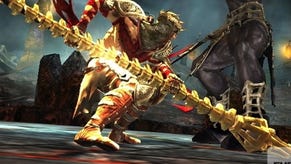Dante's Inferno
Go to Hell.
Before the playable stage, there's a suitably dramatic cut-scene rendered in a distinctively charming medieval tapestry style, with stirring music and extracts of the poem intoned with ecclesiastical menace. Disappointingly, we learn that the animations are only placeholder, with the usual ILM-smashing CGI mini-epics promised for the final release. We don't doubt that these will look spectacular (as the trailer attests), but it's not always necessary to throw money at an effects studio to make an impact. Sometimes less is more.
Control of Dante is fluid, responsive and satisfying. Initial waves of enemies, skeletal fiends that spawn from the ground like a Harryhausen movie, are thrown our way to get a feel for the controls. As with God of War, you can mash your way through these encounters untroubled, but your attacks can be finessed with mid-air grabs, throws, juggling combos and so on. And he's an agile chap, too, clambering across walls and up and down ropes with athletic ease.
The homage to Sony's title continues in the Cross-shaped status bar in the top-left, with two energy meters - one for health, the other for magic - replenished by collective coloured orbs left in the wake of dispatched foes, or prised out of chests with a few rapid taps of the circle button.
You'll gain more magic attacks as you progress; the only one available to us is Lust Storm, which produces a shimmering burst of supernatural energy to get you out of a tight spot; but we also saw listings for Sins Of The Father, Heart Of Cerberus and Suicide Fruit, which sounds like the cocktail menu in a goth pub.
The game's not out for at least another year, but is already encouragingly locked at 60 frames-per-second. And with Dante as level designer-at-large there's no excuse for a single wasted pixel in the construction of this virtual hell.

Even in a brightly lit room with multiple demo units and no headphones, the overall effect is powerful and compelling. The orchestral score is nothing short of stunning, swelling up and down with the tides of the action, strings thrashing wildly to high drama, and murmuring portentously during a carefully positioned lull. Sensibly, Virgil doesn't accompany you in-game; instead he plays the role of the omniscient narrator, booming out relevant chunks of verse at key moments during the action. It's all fabulously atmospheric.
Structurally, the playable stage sticks stubbornly to last-generation paradigms: clear away enemies; scoop up orbs; move on to next area; repeat. And progress is occasionally artificially blocked, by a wall of fire, for instance, until you've bumped off everything on-screen that moves.
This would rapidly prove a tedious formula were you simply slashing through samey sections and identikit foes over-and-over again. But at the core of Inferno's creative brief is a commitment to variety, surprise, freshness.
Knight tells us: "Obviously we want a game that feels absolutely long enough so that you feel you've completely got your money's worth. That goes without saying. But more important than length is that every level and every zone of every level gets attention from a designer. The way we work is each zone, even if it's just a combat arena, there's something about it, some object or some configuration of the enemies of the chest, or there's some little puzzle element to it or some secret area or clever way of moving the camera... Something that makes it unique from every other zone of the game."

It's the Gears of War 2 model: create a relentlessly spectacular, set-piece rollercoaster of a blockbuster, and gamers won't care if the core gameplay remains largely unchanged throughout.
"That's what I think people deserve," Knight adds. "That when they play through the game it's constantly fresh and you don't get bored and you don't feel you seeing the same patterns over and over again, and that the mechanics are being used in new and fresh ways every time. It's that novelty that we're going for and I think we've got the right design team to do it."
Speaking of which, in addition to the core team which made the excellent Dead Space, EA has hired Steve Desilet, one of the lead level designers on the Half-Life series and Oddword: Stranger's Wrath, and Mike Cheng, who worked on Metroid Prime and was lead level designed on God of War II (aha!). Meanwhile, Renowned fantasy artist Wayne Barlowe (stayed tuned for an interview with him later this week), is on character creation duties, and Knight teases that he's co-authoring the script with an "Oscar-nominated writer". The message is clear: this is a major new franchise for EA, and it's backing it to the hilt.










